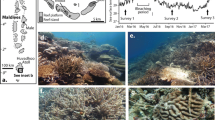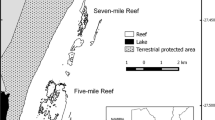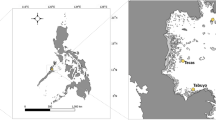Abstract
Since the bleaching event of 1998, the development of the reef flat and upper reef slope on a Maldivian reef (the Komandoo house reef; Komandoo Island, Lhaviyani atoll or Fadiffolu atoll) is under detailed observation. We quantitatively recorded specific losses, re-colonisation by coral larvae on transects on the reef flat and on dead Acropora tables at the reef slope and regeneration of partly damaged large Porites and Diploastrea—colonies over the period from 1999 to 2004. The detrimental effects on the reef structure by bioerosion and hydrodynamics, as well as the overall status of the reef community were qualitatively assessed. Recruitment soon after the bleaching was more pronounced than in the following years, Pavona varians being a main constituent. The temporal re-colonisation pattern points at an emergency spawning of local Scleractinia just prior to the bleaching, whereas a sharp decrease of young settlers in 2001 and 2002 confirms a reduction of fertile colonies. The dominant species in the coral community shifted from acroporids and pocilloporids to agariciids. The skeletal deposition of recovering Diploastrea heliopora was equivalent to that before the bleaching, but much less than that of neighbouring Porites lobata colonies. The slow and scattered formation of new reef substance, which would structurally strengthen the reef, is however outweighed by the collapse of dead protruding and spacious colonies (e.g., Acropora tables). Six years after the bleaching, the formerly three-dimensional structure of the reef flat and upper reef slope presents as a levelled field of rubble, only partly consolidated by incrusting corals. Considering the recurrence of bleaching events (1987, 1998) and the results of the present study, one may assume a cascading deterioration of the status of the reef for the future.

















Similar content being viewed by others
References
Allison WR (1995) Degradation and recocery of Maldivian reefs. Reef Encounter 17:6–7
Allison WR (2002) Long term changes in Maldivian coral reef communities. Int Soc Reef Stud, Eur Meet Cambridge, Abstr Vol 8
Aronson RB, Precht WF (2001) White-band diseases and the changing face of Caribbean coral reefs. Hydrobiologia 460:25–38
Baird AH, Marshall PA (2002) Mortality, growth and reproduction in scleractinian corals following bleaching on the Great Barrier Reef. Mar Ecol Prog Ser 237:133–141
Bianchi CN, Pichon M, Morri C, Colantoni P, Bernardini G, Benzoni F, Baldelli G (2002) Patterns of coral mortality, survival and recruitment in Maldivian coral reefs, following the 1998 bleaching event. Int Soc Reef Stud, Eur Meet Cambridge, Abstr Vol 14
Bianchi CN, Pichon M, Morri C, Colantoni P, Benzoni F, Baldelli G Le suivi du blanchissement des coraux aux Maldives: les lecons à tirer et nouvelles hypothèses. Oceanis (in press)
Buddemeier RW, Fautin DG (1993) Coral bleaching as an adaptive mechanism: a testable hypothesis. Bio Sci 43:320–326
Ciarapica G, Passeri L (1999) Coral bleaching in the Maldives (Ari Atoll). Reef Encounter 26:19–21
Coles SL, Brown BE (2003) Coral bleaching–capacity for accli-matization and adaptation. Adv Mar Biol 46:183–223
Eakin CM (1996) Where have all the carbonates gone? A model comparison of calcium carbonate budgets before and after the 1982–1983 El Nino at Uva Island in the eastern Pacific. Coral Reefs 15:109–119
Edwards AJ, Clark S, Zahir H, Rajasuriya A, Naseer A, Rubens J (2001) Coral bleaching and mortality on artificial and natural reefs in Maldives in 1998, sea surface temperature anomalies and initial recovery. Mar Pollut Bull 42:7–15
Eisinger M (2005) Beiträge zu ökologischen und ökonomischen Aspekten der Korallentransplantation auf elektrochemisch erzeugte Substrate als Methode zur Rehabilitation degradierter Korallenriffe. PhD thesis, Univ Duisburg-Essen, 165 pp
Heiss GA, Dullo W-Chr, Reijmer JJ (1993) Short - and long-term growth history of massive Porites sp.from Aqaba (Red Sea). Senckenbergiana Marit 23:135–141
Hoegh-Guldberg O (1999) Climate change, coral bleaching and the future of the world's coral reefs. Mar Fresh Water Res 50:839–866
Hutchings PA, Peyrot-Clausade M, Stuken A (2004) Impact of bleaching on rates and agents of bioerosion on the GBR. 10th Int Coral Reef Symp Okinawa, Abstr, p 132
Kayanne H, Harii S, Ide Y, Akimoto F (2002) Recovery of coral populations after the 1998 bleaching on Shiraho Reef, in the southern Ryukyus, NW Pacific. Mar Ecol Prog Ser 239:93–103
Kleypas JA, Buddemeier RW, Gattuso JP (2001) The future of coral reefs in an age of global change. Int J Earth Sci 90:426–437
Kokita T, Nakazono A (2001) Rapid response of an obligately corallivorous filefish Oxymonacanthus longirostris (Monacanthidae) to a mass coral bleaching event. Coral Reefs 20:155–158
LaJeunesse TC, Thornhill DJ, Cox EF, Stanton FG, Fitt WK, Schmidt GW (2004) High diversity and host specificity observed among symbiotic dinoflagellates in reef coral communities from Hawaii. Coral Reefs 23:596–603
Loch K, Loch W, Schuhmacher H, See WR (2002) Coral recruitment and regeneration on a Maldivian reef 21 months after the coral bleaching event of 1998. PSZN Mar Ecol 23:219–236
Loch K, Loch W, Schuhmacher H, See WR (2004) Coral recruitment and regeneration on a Maldivian reef four years after the coral bleaching event of 1998. Part 2: 2001–2002. Mar Ecol 25:145–154
Lough JM, Barnes DJ (1997) Several centuries of variation in skeletal extension, density and calcification in massive Porites colonies from the Great Barrier reef: a proxy for seawater temperature and a background of variability against which to identify unnatural change. J Exp Mar Biol Ecol 211:26–67
Marshall PA, Baird AH (2000) Bleaching of corals on the Great Barrier Reef: differential susceptibilities among taxa. Coral Reefs 19:155–163
McClanahan TR (2000) Bleaching damage and recovery potential of Maldivian coral reefs. Mar Pollut Bull 40:587–597
Rajasuriya A, Venkataraman K, Muley EV, Zahir H, Cattermoul B (2002) Status of coral reefs in South Asia: Bangladesh, India, Maldives, Sri Lanka. In: Wilkinson C (ed) Status of coral reefs of the world 2002. Australian Institute of Marine Science, Townsville, pp 101–121
Reaka-Kudla ML, Feingold JS, Glynn W (1996) Experimental studies of rapid bioerosion of corals reefs in the Galápagos Islands. Coral Reefs 15:101–107
Richmond RH (1987) Energetics, competency, and longdistance dispersal of planula larvae of the coral Pocillopora damicornis. Mar Biol 93:527–533
Scheer G (1971) Coral reefs and coral genera in the Red Sea and Indian Ocean. Symp Zool Soc Lond 28:329–367
Scheer G Investigation of coral reefs at Rasdu Atoll in the Maldives with the quadrat method according to phytosociology. In: Proceedings of 2nd International Coral Reef Symposium, vol. 2:655–670, Brisbane 1974
Schuhmacher H Development of coral communities on artificial reef types over 20 years (Eilat, Red Sea). In: Proceedings of 6th International Coral Reef Symposium, vol. 3,:pp 379–384Townsville, 1988
Schuhmacher H, van Treeck P, Eisinger M, Paster M (2002a) Transplantation of coral fragments from ship groundings on electrochemically formed reef structures. In: Proceedings of 9th International Coral Reef Symposium, vol. 2:pp 983–990Bali, Indonesia, 2000
Schuhmacher H, Loch K, Loch W (2002b) Post-bleaching growth reveals Diploastrea heliopora to be a coral methusalem. Coral Reefs 21:344–345
Soong K, Chen CA, Chang JC (1999) A very large poritid colony at Green Island, Taiwan. Coral Reefs 18:42
Sprecher SG, Galle S, Reichert H (2003) Substrate specificity and juvenile faviid predominance of coral colonization at the Maldive Islands following the 1998 bleaching event. Coral Reefs 22:130–132
Stoddart DR (1966) Reef studies at Addu Atoll, Maldive Islands. Preliminary results of an expedition to Addu Atoll in 1964. Atoll Res Bull 116:1–122
Tanner JE, Hughes TP, Connell J (1994) Species coexistence, keystone species, and succession: a sensitivity analysis. Ecology 75:2204–2219
Tsuchiya M (1999) Effect of mass coral bleaching on the community structure of small animals associated with the hermatypic coral Pocillopora damicornis. Galaxea JCRS 1:65–72
Ward S, Harrison P, Hoegh-Guldberg O (2002) Coral bleaching reduces reproduction of scleractinian corals and increases susceptibility to future stress. In: Proceedings of 9th International Coral Reef Symposium, vol.2:pp 1123–1128 Bali, Indonesia, 2000
Wilkinson C (2000) Status of the coral reefs of the world: 2000. Australian Institute of Marine Science, Townsville, Australia, pp 363
Wilkinson C, Linden O, Cesar H, Hodgson G, Rubens J, Strong AE (1999) Ecological and socioeconomic impacts of 1998 coral mortality in the Indian Ocean: An ENSO impact and a warning of future change? Ambio 28:188–196
Zahir H (2002) Status of the coral reefs of Maldives. In: Linden O, Souter D, Wihelmsson D, Obura D (eds) Coral reef degradation in the Indian Ocean. Status Rep 2002 CORDIO, Stockholm, pp 119–124
Zahir H, Clark S, Agila R, Saleem M (2002) Spatial and temporal patterns of coral recruitment following a severe bleaching event in the Maldives. In: Linden O, Souter D, Wihelmsson D, Obura D (eds) Coral reef degradation in the Indian Ocean. Status Rep 2002 CORDIO, Stockholm, pp 125–134
Acknowledgement
The authors gratefully acknowledge the skilful preparation of the computer-tomogram of the Diploastrea core by Dr Drewes and partners, Osnabrück.
Author information
Authors and Affiliations
Corresponding author
Rights and permissions
About this article
Cite this article
Schuhmacher, H., Loch, K., Loch, W. et al. The aftermath of coral bleaching on a Maldivian reef—a quantitative study. Facies 51, 80–92 (2005). https://doi.org/10.1007/s10347-005-0020-6
Received:
Accepted:
Published:
Issue Date:
DOI: https://doi.org/10.1007/s10347-005-0020-6




